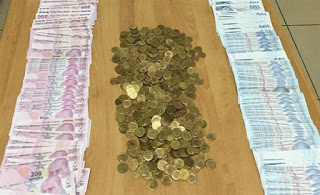
PREV ARTICLE
NEXT ARTICLE
FULL ISSUE
PREV FULL ISSUE
OTTOMAN-ERA COIN CACHE SEIZED IN ISTANBUL
Arthur Shippee forwarded this article about a cache of Ottoman-era coins seized in Istanbul. He found the link via the Explorator
newsletter. Thanks. -Editor
Antiquities trafficking from source countries to collector markets requires a global network of routes and facilitation by domestic and international criminal groups and, or middle men. Although the various trajectories are always evolving, there are certain well-established trafficking routes regularly used for the purpose of transporting illicit goods, be they drugs, precursor chemicals, illicit arms, humans or portable antiquities But does Turkey serve as a trade route for illicit antiquities?
€119,000 (Euros) ₺134,500 (Turkish lira) $4,250 (US Dollars) Is the antiquities trade always tied to the illicit drug trade? Certainly not. However one could conclude that underworld figures willing to ply their trade with one black market item (heroin) might be convinced to transport/fence other lucrative goods (coins) available on the illicit market if and when opportunity knocks and they are presented with objects for which there are likely to be buyers. Is the antiquities trade tied to one specific district? Again certainly not. Nor should any parallel be drawn by any of our readers connecting these two isolated events in one distinct of Istanbul. The lack of solid statistical reporting in the field of heritage-related crimes and the clandestine nature of illicit trafficking in general make drawing conclusions as to how often one type of illicit trafficking overlaps with another impossible to ascertain. What is important however is that we actively recognize that fluid network structures, rather than more formal hierarchies, coupled with porous borders and geographical proximity to destabilized source countries located in the vicinity of established trafficking corridors where transnational criminal networks are already active could be leveraged as a means to traffic movable heritage. It should also be understood that the average participant may not be a career criminal, but a regular citizen attempting to exploit an opportunity to supplement their income as a single link in a complex chain. To read the complete article, see:
Wayne Homren, Editor The Numismatic Bibliomania Society is a non-profit organization promoting numismatic literature. See our web site at coinbooks.org. To submit items for publication in The E-Sylum, write to the Editor at this address: whomren@gmail.com To subscribe go to: https://my.binhost.com/lists/listinfo/esylum All Rights Reserved. NBS Home Page Contact the NBS webmaster 
|
